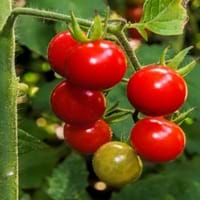Life Span
Perennial
Annual
Type
Bulb or Corm or Tuber
Vegetable
Origin
South America
Mexico, Central America, South America
Types
Pamianthe cardenasii , Pamianthe parviflora , Pamianthe peruviana
Red, Yellow and Baby Plum
Number of Varieties
Not Available
Habitat
All sorts of environments
Cultivated Beds
USDA Hardiness Zone
8-10
11-15
Sunset Zone
21,22
A1, A2, A3, H1, H2, 1a, 1b, 2a, 2b, 3a, 3b, 4, 5, 6, 7, 8, 9, 10, 11, 12, 13, 14, 15, 16, 17, 18, 19, 20, 21, 22, 23, 24
Habit
Clump-Forming
Upright/Erect
Flower Color
White
Yellow
Flower Color Modifier
Bicolor
Bicolor
Leaf Color in Spring
Dark Green
Green, Dark Green
Leaf Color in Summer
Light Green
Green, Dark Green
Leaf Color in Fall
Several shades of Green
Green, Dark Green
Leaf Color in Winter
Light Green
Green, Dark Green
Leaf Shape
Strap shaped
Lanceolate
Plant Season
Spring, Summer, Fall
Spring, Summer, Fall
Sunlight
Partial Sun, Partial shade
Full Sun
Type of Soil
Loam, Sand
Loam, Sand
The pH of Soil
Acidic, Neutral, Alkaline
Neutral
Soil Drainage
Average
Well drained
Bloom Time
Spring, Late Spring, Early Summer, Summer, Late Summer
Indeterminate
Tolerances
Drought
Drought
Where to Plant?
Ground, Pot
Container, Ground, Pot
How to Plant?
Offsets
Seedlings
Plant Maintenance
Medium
Medium
Watering Requirements
Keep the ground moist but not water-logged
Requires regular watering
In Summer
Lots of watering
Lots of watering
In Spring
Moderate
Moderate
In Winter
Average Water
Average Water
Soil pH
Acidic, Neutral, Alkaline
Neutral
Soil Type
Loam, Sand
Loam, Sand
Soil Drainage Capacity
Average
Well drained
Sun Exposure
Partial Sun, Partial shade
Full Sun
Pruning
Pinch or prune as they grow to promote branching and bushiness, Remove damaged leaves, Remove dead branches, Remove dead leaves, Requires little pruning
Dispose of diseased portions, Remove dead leaves
Fertilizers
All-Purpose Liquid Fertilizer, High phosphorus
organic fertlizers
Pests and Diseases
Leaf spot, Mosaic viruses
fungus
Plant Tolerance
Drought
Heat Tolerance
Flower Petal Number
Single
Single
Fragrant Bark/Stem
No
Yes
Foliage Texture
Coarse
Medium
Foliage Sheen
Glossy
Matte
Attracts
Bees, Birds, Bumblebees, Butterflies, Hummingbirds, pollinators
Butterflies
Allergy
Unknown
Diarrhea, gastro-intestinal problems, Headache, Itchiness, Vomiting
Aesthetic Uses
Beautification, Bouquets, Ornamental use, Showy Purposes
As decorated salad
Beauty Benefits
No Beauty Benefits
Acne, Glowing Skin, Maintains teeth healthy
Environmental Uses
Air purification
Air purification
Medicinal Uses
No Medicinal Use
Antioxidants, Metabolism
Part of Plant Used
Not Available
Fruits
Other Uses
Beneficial species for attracting pollinators, Decoration Purposes
Cosmetics, Culinary use, For making oil, Repellent
Used As Indoor Plant
No
Yes
Used As Outdoor Plant
Yes
Yes
Garden Design
Bog Garden, Container, Feature Plant, Foundation, Mixed Border, Water Gardens
Container, Edible, Herb, Vegetable, Houseplant
Botanical Name
HYMENOCALLIS longipetala
LYCOPERSICON esculentum 'Tiny Tim'
Common Name
Peruvian Daffodil, Spiderlily
Cherry Tomato
In Hindi
peruvian daffodil
चेरी टमाटर
In German
peruvian daffodil
Kirschtomate
In French
peruvian daffodil
Tomate cerise
In Spanish
Pamianthe
Tomate cherry
In Greek
peruvian daffodil
Ντοματάκι
In Portuguese
peruvian daffodil
Tomate cereja
In Polish
peruvian daffodil
Pomidor wiśniowy
In Latin
peruvian daffodil
Cherry LycopersiciSusceptibility
Phylum
Magnoliophyta
Magnoliophyta
Class
Liliopsida
Magnoliopsida
Order
Asparagales
Solanales
Family
Amaryllidaceae
Solanaceae
Clade
Angiosperms, Monocots
Angiosperms, Asterids, Eudicots
Tribe
Clinantheae
Solaneae
Subfamily
Amaryllidoideae
Solanoideae
Number of Species
Not Available
Not Available
Season and Care of Peruvian Daffodil and Cherry Tomato
Season and care of Peruvian Daffodil and Cherry Tomato is important to know. While considering everything about Peruvian Daffodil and Cherry Tomato Care, growing season is an essential factor. Peruvian Daffodil season is Spring, Summer and Fall and Cherry Tomato season is Spring, Summer and Fall. The type of soil for Peruvian Daffodil is Loam, Sand and for Cherry Tomato is Loam, Sand while the PH of soil for Peruvian Daffodil is Acidic, Neutral, Alkaline and for Cherry Tomato is Neutral.
Peruvian Daffodil and Cherry Tomato Physical Information
Peruvian Daffodil and Cherry Tomato physical information is very important for comparison. Peruvian Daffodil height is 61.00 cm and width 61.00 cm whereas Cherry Tomato height is 3,050.00 cm and width 30.50 cm. The color specification of Peruvian Daffodil and Cherry Tomato are as follows:
Peruvian Daffodil flower color: White
Peruvian Daffodil leaf color: Dark Green
Cherry Tomato flower color: Yellow
- Cherry Tomato leaf color: Green and Dark Green
Care of Peruvian Daffodil and Cherry Tomato
Care of Peruvian Daffodil and Cherry Tomato include pruning, fertilizers, watering etc. Peruvian Daffodil pruning is done Pinch or prune as they grow to promote branching and bushiness, Remove damaged leaves, Remove dead branches, Remove dead leaves and Requires little pruning and Cherry Tomato pruning is done Dispose of diseased portions and Remove dead leaves. In summer Peruvian Daffodil needs Lots of watering and in winter, it needs Average Water. Whereas, in summer Cherry Tomato needs Lots of watering and in winter, it needs Average Water.





